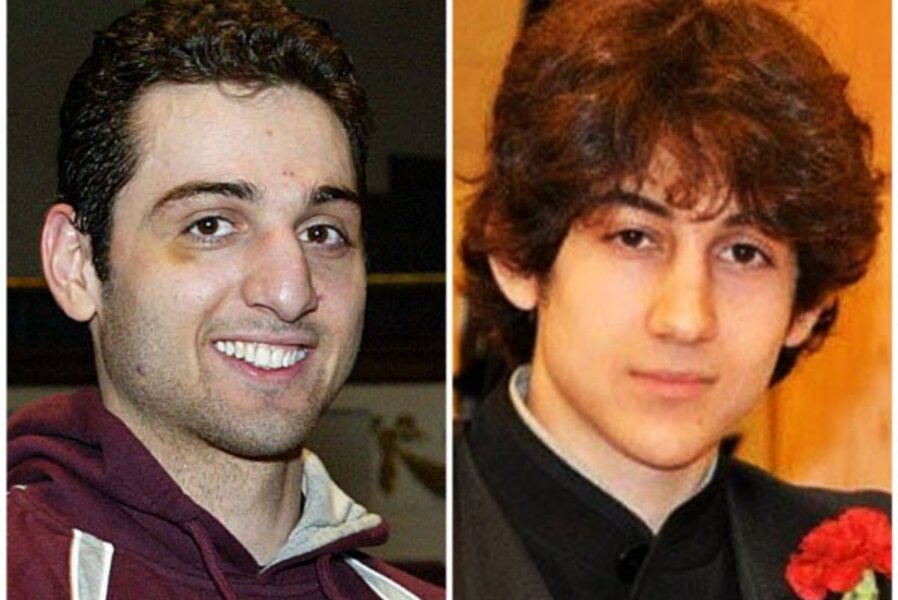Boston Marathon bombing: Is American jihadism on the rise?
Loading...
The emerging portrait of the brothers Tsarnaev, deceased 26-year-old Tamerlan and Dzhokhar, 19, both implicated in a terrorist bomb attack at the Boston Marathon, is one that increasingly describes a pair of homegrown American jihadis.
However what caused Tamerlan and Dzhokhar, who shared an apartment in Cambridge, Mass., to “radicalize” – going from young party-throwing American immigrants to suspected bomb-toting terrorists willing to wreak destruction on their adopted country – isn’t known yet.
Relatives and friends describe a shift in Tamerlan, beginning around 2009, in which he suddenly delved into Islam and tossed aside his boxing career. But even before he left the sport he was quoted, now famously, as saying that he had no American friends and didn’t understand them.
For his part, Dzhokhar was reported Tuesday to have told investigators from his hospital bed that he and his brother read “Inspire,” an online magazine published by Al Qaeda in the Arabian Peninsula. If so, the pair would not be the first Americans to take inspiration and operational advice on how to conduct mayhem from that jihadi magazine, which first appeared in mid-2010.
But for clearer answers on why the brothers turned to violence, government intelligence agencies are still analyzing the suspects’ backgrounds, their FaceBook pages, immigration information, travel connections, and biographical data. Whom, for instance, did Tamerlan meet with during his trip last year to Dagestan, a republic in Russia's south that borders Chechnya?
What does seem to be getting clearer, though, is that the Boston Marathon bomb attack that killed three people and wounded more than 280 appears to fit a national portrait in domestic jihadism – mostly attempted plots with a handful of attacks – that have bubbled up from within America over the past decade.
There have been 63 homegrown violent jihadist plots or attacks in the United States since Sept. 11, 2001, the Congressional Research Service (CRS) reported in January. Two-thirds of those – 40 plots and two attacks –were uncovered or occurred between April 2009 and December 2012.
“Most of the 2009-2012 homegrown plots likely reflect a trend in jihadist terrorist activity away from schemes directed by core members of significant terrorist groups such as Al Qaeda,” the CRS reported. “It may be too early to tell how sustained this uptick is.... Regardless, the apparent spike in such activity after April 2009 suggests that ideologies supporting violent jihad continue to influence some Americans – even if a tiny minority.”
But there is serious disagreement about this “spike” in home-grown jihadi activity. Are the Tsarnaev brothers part of a dangerous upswing in homegrown American jihadism since 2009 – or the rare exception in a vastly diminished, quickly receding threat?
“The circumstances of this [Boston Marathon] case are a little different, but it does seem to reinforce the overall pattern, the spike that we’ve seen since 2009,” says Jarret Brachman, author of “Global Jihadism,” and former director of research at the Combating Terrorism Center at West Point. “There’s been increasing silence by Al Qaeda’s senior leadership, but an evolution toward outsourcing Al Qaeda operations to the grass roots.”
But if the number of indictments, uncovered plots, and actual attacks have surged since 2009, other researchers say another statistic, the number of participants in the homegrown terror plots, tells a different story.
“I certainly agree there was a big spike in 2009 and 2010, but our data show that Muslim-American terrorism is declining,” says David Schanzer, director of the Triangle Center of Terrorism and Homeland Security in Durham, N.C. “We’re seeing domestic jihadi terrorism declining further. The facts are we’ve seen a drop off in the last three years.”
By looking at the number of those arrested on terrorism charges, not just the number of plots they are involved with, it becomes clear that the number of participants involved in homegrown jihadism is shrinking, he and others say.
Fourteen Muslim-Americans were indicted for violent terrorist plots in 2012, a drop from 21 the year before, according to a Triangle Center study released in February. The number of plots also dropped from 18 in 2011 to 9 in 2012.
“The director of the FBI in 2003 testified before Congress that Americans should expect hundreds of terrorist attacks in shopping malls, stores, and schools,” says Charles Kurzman, a professor of sociology at the University of North Carolina at Chapel Hill and author of the recent Triangle Center study.
“Fortunately we have not seen anywhere near that level of terrorist violence. Part of that is due to good policing that has disrupted plots,” he say. “But the decline also has to be because Muslim Americans have resisted calls to violent activity and share more values with their American neighbors than revolutionary movements overseas.”
Since 9/11, and not including the marathon bombing, Muslim-American terrorism has left 33 dead in the United States, Dr. Kurzman’s study found. During the same period, more than 180,000 murders were committed in the US – with more than 200 Americans killed in political violence by white supremacists and other groups on the far right, according to a recent study published by the Combating Terrorism Center at the US Military Academy.
For perspective, the volume of US domestic terrorist activity was far greater in the 1970s than it is today, with 60 to 70 terrorist incidents, mostly bombings, on US soil each year, according to a 2010 RAND study. In the nine-year period from 1970 to 1978, 72 people were killed in terrorist incidents, more than five times as many as were killed by jihadist terrorists in the United States in the nine years following 9/11, writes Brian Jenkins, the study’s author.
Still other experts contend that the 2009-2010 “spike” in cases of domestic jihadism and the overall increase since then are reflective more of the policies of federal investigators. The threat of big-scale terrorist violence “has pushed law enforcement toward prevention rather than criminal apprehension after an event – or, as one senior police official put it, ‘staying to the left of the boom,’ which means stopping the explosions or attacks before they occur,” Mr. Jenkins writes.
Such policies result in inflated numbers that may give Americans an exaggerated fear of the threat from homegrown jihadism – and distract resources from catching the likes of the Tsarnaev brothers, some experts say.
“These arrest numbers are soft,” says Marc Sageman, an independent counter-terrorism researcher and former Central Intelligence Agency case officer. “They don’t look at whether the attacks would have occurred without FBI involvement in many of them as sting operations.”
A change in federal strategy, beginning around 2009, led to an increased focus on drawing out those involved in online discussions about attacking the US, he says.
“Before it was just these guys fantasizing about attacking,” Dr. Sageman says. “Now they get someone – an FBI informant – saying, ‘I’ll get you weapons.’ This did not occur very often prior to 2009. So, basically, what you are seeing is a very aggressive counter-terrorism strategy where a lot of people on the Internet are threatening government authority – but absent the FBI – it’s doubtful anything would have happened.”
Other experts are less sure. Online forums, websites, chat rooms, and other online means of disseminating Al Qaeda’s message – especially it’s online magazine “Inspire” that once included an article entitled “How to make a bomb in the kitchen of your mom” – is proving to be a potent means for cultivating jihadis, they say.
Dr. Brachman worried the Boston Marathon bombing is just one sign that Al Qaeda, which has struggled to get young Western male Muslims embrace the idea of attacking the societies they live in – now may have “cracked the formula on how to radicalize a young Muslim male in the West – one who feels culturally dislocated and may be dealing with personal grief.”
Al Qaeda’s “Inspire” purports to supply a rationale – and a solution – for the predicament faced by a small subset of American Muslims who may find themselves not fitting in and alienated from society, he says. The magazine creates for its readers a funnel that systematically works the reader through a process, explaining that all the disappointment, anger and failure are a result of one thing – the western “war on Islam” – and that the only solution is to fight back.
“I think we have to be concerned now about what we’ve seen demonstrated with the Tsarnaev brothers in Boston,” says Brachman. “Dzhokhar’s admission to the authorities that he and his brother read 'Inspire' isn’t just about how to build bombs. The fact they were reading and drawing on 'Inspire' is significant and reflective of a pattern we’re seeing in homegrown jihadism. He may be seeing these heroes of the Al Qaeda movement and saying to himself – “maybe I can be like them.”








